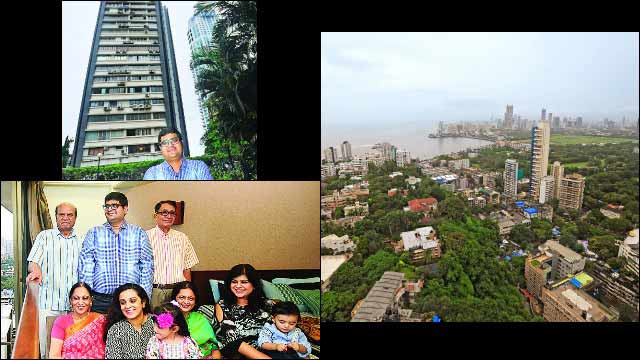Glory days in city's first skyscraper
It's long been dwarfed by constructions far and near, but life in Carmichael Road's Usha Kiran building is about feeling at home, resident Anant Patel tells Marisha Karwa

Updated : Dec 05, 2017, 02:02 PM IST
The elevator at the world's tallest structure, Burj Khalifa, is said to move so rapidly that floor numbers change faster than the blink of an eye. Dubai's 829.8m glass-and-steel structure is a sheer Gulliver to the estimated 109m* mass of concrete that is Usha Kiran building in Mumbai's Carmichael Road neighbourhood, but the 25-floor residential building is by no means Lilliputian. It was said to be the tallest building in Asia at the time of construction, and upon completion, became the first skyscraper in the country.
This was in the 1960s — the decade in which the Berlin Wall was built; when Yuri Gagarin became the first man to reach space; when the India-China war crushed the nation's confidence and when RD Burman made his debut as a music director for Chhote Nawab.
"It was one of the few buildings to have its own swimming pool back then," says Anant Patel, a third generation resident. "My grandparents moved into Usha Kiran in 1971 along with my parents. They always spoke about the breathtaking view and the clean air, which made it possible to see as far as Uran in the south and Borivali National Park in the north."
TRENDING NOW
Patel recalls a time of convivial childhood. "My earliest memories are of playing with my friends. The playground had a slide, swings and a see-saw. And as we grew up, we played cricket and spent hours skateboarding and cycling," says the 34-year-old. "I also remember the frequent slumber parties at each other's homes."
In many ways, Usha Kiran defined a lavish lifestyle, and continues to do so today. Each floor features two apartments, ranging from 3,200sqft to 3,300sqft. And with five elevators to service 50 apartments, residents seldom have to linger or wait after having pushed the call button. Patel savours the fact that the building feels like home even after all these years. "Everyone (in the building) is friendly and down to earth so everyone relates to each other as friends," says the managing director and co-founder of Veranta Labs Private Limited, which recently launched the gift registry platform Wrapp'd. "Even the security staff at Usha Kiran are building employees. Most have been with us since my childhood and thus share a unique relationship with every member."
From skyscrapers to supertalls
Usha Kiran's glory was tarnished when Matru Mandir, another 25-floor building, came up at Nana Chowk a few years later. At the turn of the decade, both the buildings were shadowed by the 156m World Trade Centre tower at Cuffe Parade in 1970. Before long, high-rises came to be a regular feature on the Mumbai skyline. But it was only after the turn of the century that skyscrapers and supertalls (a special class of skyscraper) came to dominate the city's skyline. The 45-storeyed, 160m Shreepati Arcade at Nana Chowk, which became the tallest building in the city in 2002, is now dwarfed by the likes of Imperial Towers (Tardeo), Planet Godrej (Mahalaxmi), and the under-construction World One (Lower Parel) and Palais Royale (Worli).
Patel harks to the time when there was "practically no high-rise anywhere in sight" from the bedroom of his 23rd floor apartment in Usha Kiran. "At first, I was not aware of the (history of the) building. I took for granted the view, the quality of light, air and spaciousness of my home," he says. "As I grew up, I became conscious of this and began appreciating them."
Patel remembers being able to see all the way up to the airport from the northeast-facing room back then. "Today, the furthest I can see clearly is the Bandra-Worli Sea Link."
The view might have changed, but the make-up of his family hasn't. Patel continues to live in the same apartment with his parents, uncle and aunt, his wife and their two children, making the latter the fourth generation in the Patel residence. This, even though most friends he grew up with have moved elsewhere.
When old is gold
"I visit a lot of these friends in new buildings, which feel like (living in) hotels. It takes a long time to enter and exit most such buildings," says Patel, adding that the feeling of homeliness doesn't exist in modern structures. The only thing he misses in Usha Kiran is the swimming pool, which "had to be discontinued around my birth because of acute water shortage in the city at the time", says Patel, who is actively involved in the building's management.
In the more than three decades that he has lived here, the premises have witnessed the addition of a gymnasium, a toddler playground, a yoga room, a pool table room, a table tennis room, a basketball court and a volleyball court. "We recently upgraded the elevators to have modern, high-speed elevators. And because we have a unique member-to-elevator ratio (one-elevator-per-10-flats), it makes for very comfortable living."
As for the limiting view of the
cityscape, Patel feels that it's the result of increased air pollution
and not just a result of the growing number of high-rises. "I don't
remember a time when I saw haze outside when I was growing up. But
today, it's a rarity to have a clear day," he rues.
(*Estimation based on building records)
==============================================
CC
Hum Panchi Mastane
Singers: Lata Mangeshkar, Geeta Dutt
Performers: Shubha Khote, Anita Guha
Music: Madan Mohan
Lyrics: Rajinder Krishan
Film: Dekh Kabira Roya, 1957
Cast: Anita Guha, Shubha Khote, Ameeta, Anoop Kumar, Daljit, Jawahar Kaul, Sunder, Shivraj, Praveen Paul==============================================
)

